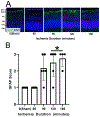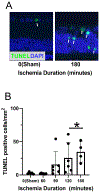Assessment of retinal oxygen metabolism, visual function, thickness and degeneration markers after variable ischemia/reperfusion in rats
- PMID: 34774489
- PMCID: PMC8665131
- DOI: 10.1016/j.exer.2021.108838
Assessment of retinal oxygen metabolism, visual function, thickness and degeneration markers after variable ischemia/reperfusion in rats
Abstract
After total retinal ischemia induced experimentally by ophthalmic vessel occlusion followed by reperfusion, studies have reported alterations in retinal oxygen metabolism (MO2), delivery (DO2), and extraction fraction (OEF), as well as visual dysfunction and cell loss. In the current study, under variable durations of ischemia/reperfusion, changes in these oxygen metrics, visual function, retinal thickness, and degeneration markers (gliosis and apoptosis) were assessed and related. Additionally, the prognostic value of MO2 for predicting visual function and retinal thickness outcomes was reported. Sixty-one rats were divided into 5 groups of ischemia duration (0 [sham], 60, 90, 120, or 180 min) and 2 reperfusion durations (1 h, 7 days). Phosphorescence lifetime and blood flow imaging, electroretinography, and optical coherence tomography were performed. MO2 reduction was related to visual dysfunction, retinal thinning, increased gliosis and apoptosis after 7-days reperfusion. Impairment in MO2 after 1-h reperfusion predicted visual function and retinal thickness outcomes after 7-days reperfusion. Since MO2 can be measured in humans, findings from analogous studies may find value in the clinical setting.
Keywords: Ophthalmic vessel occlusion; Retinal ischemia; Retinal oxygen metabolism.
Copyright © 2021 Elsevier Ltd. All rights reserved.
Conflict of interest statement
Disclosure
MS holds a patent for the oxygen imaging technology. The authors have no conflict of interest.
Figures








Similar articles
-
Quantifying retinal oxygenation and metabolism by phosphorescence lifetime imaging.Exp Eye Res. 2025 Aug;257:110422. doi: 10.1016/j.exer.2025.110422. Epub 2025 May 15. Exp Eye Res. 2025. PMID: 40381978 Review.
-
Relation of Retinal Oxygen Measures to Electrophysiology and Survival Indicators after Permanent, Incomplete Ischemia in Rats.Transl Stroke Res. 2020 Dec;11(6):1273-1286. doi: 10.1007/s12975-020-00799-9. Epub 2020 Mar 24. Transl Stroke Res. 2020. PMID: 32207038 Free PMC article.
-
Alterations in Retinal Oxygen Delivery, Metabolism, and Extraction Fraction During Bilateral Common Carotid Artery Occlusion in Rats.Invest Ophthalmol Vis Sci. 2019 Jul 1;60(8):3247-3253. doi: 10.1167/iovs.19-27227. Invest Ophthalmol Vis Sci. 2019. PMID: 31343655 Free PMC article.
-
Assessment of inner retinal oxygen metrics and thickness in a mouse model of inherited retinal degeneration.Exp Eye Res. 2021 Apr;205:108480. doi: 10.1016/j.exer.2021.108480. Epub 2021 Feb 2. Exp Eye Res. 2021. PMID: 33539865 Free PMC article.
-
[Retinal neuronal cell death: molecular mechanism and neuroprotection].Nippon Ganka Gakkai Zasshi. 2001 Dec;105(12):884-902. Nippon Ganka Gakkai Zasshi. 2001. PMID: 11802459 Review. Japanese.
Cited by
-
Quantifying retinal oxygenation and metabolism by phosphorescence lifetime imaging.Exp Eye Res. 2025 Aug;257:110422. doi: 10.1016/j.exer.2025.110422. Epub 2025 May 15. Exp Eye Res. 2025. PMID: 40381978 Review.
-
The accumulated oxygen deficit as an indicator of the ischemic retinal insult.Exp Eye Res. 2023 May;230:109439. doi: 10.1016/j.exer.2023.109439. Epub 2023 Mar 15. Exp Eye Res. 2023. PMID: 36931487 Free PMC article.
-
CREG Protects Retinal Ganglion Cells loss and Retinal Function Impairment Against ischemia-reperfusion Injury in mice via Akt Signaling Pathway.Mol Neurobiol. 2023 Oct;60(10):6018-6028. doi: 10.1007/s12035-023-03466-w. Epub 2023 Jul 4. Mol Neurobiol. 2023. PMID: 37402034
-
Impairments of retinal hemodynamics and oxygen metrics in ocular hypertension-induced ischemia-reperfusion.Exp Eye Res. 2022 Dec;225:109278. doi: 10.1016/j.exer.2022.109278. Epub 2022 Oct 15. Exp Eye Res. 2022. PMID: 36252653 Free PMC article.
-
Ucf-101 alleviates Ischaemia/Reperfusion induced retinal inflammation and injury via suppressing oxidative damage.J Mol Histol. 2024 Aug;55(4):455-464. doi: 10.1007/s10735-024-10213-5. Epub 2024 Jun 15. J Mol Histol. 2024. PMID: 38877338
References
-
- Behzadian MA, Wang XL, Windsor LJ, Ghaly N, Caldwell RB, 2001. TGF-beta increases retinal endothelial cell permeability by increasing MMP-9: possible role of glial cells in endothelial barrier function. Invest Ophthalmol Vis Sci 42, 853–859. - PubMed
-
- Bhisitkul RB, Robinson GS, Moulton RS, Claffey KP, Gragoudas ES, Miller JW, 2005. An antisense oligodeoxynucleotide against vascular endothelial growth factor in a nonhuman primate model of iris neovascularization. Arch Ophthalmol 123, 214–219. - PubMed
Publication types
MeSH terms
Substances
Grants and funding
LinkOut - more resources
Full Text Sources

